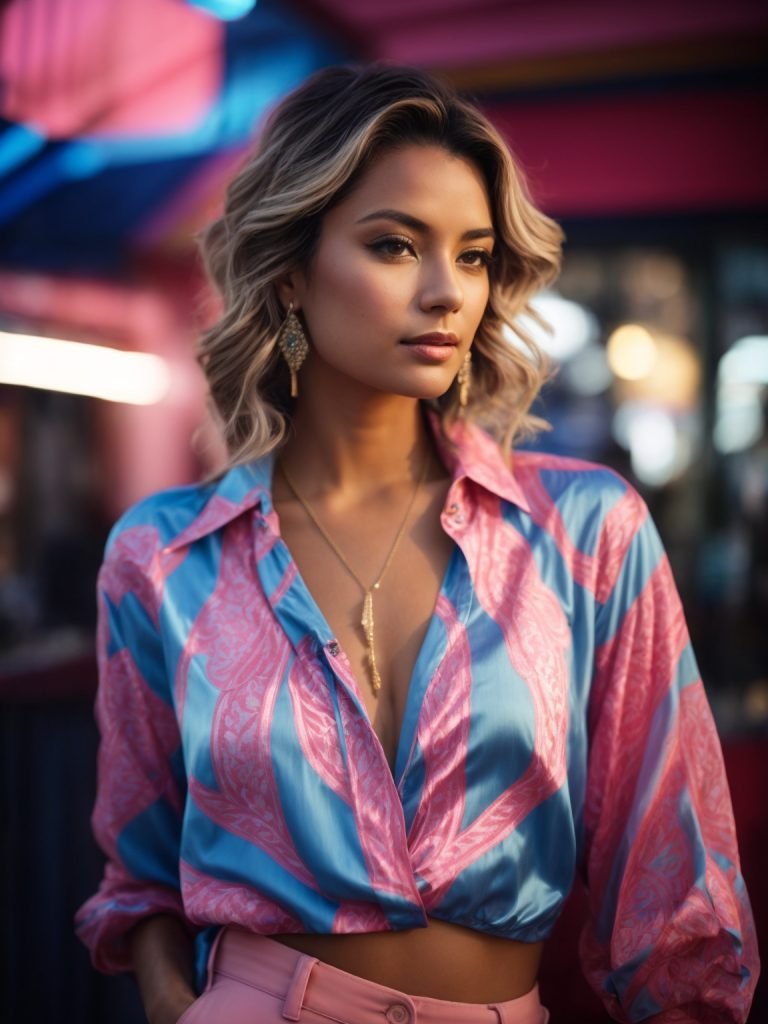Key Takeaways
- Understanding the balance between warm and cool tones.
- Importance of color theory in fashion.
- How to effortlessly mix and match warm and cool colors.
- Identifying your personal color palette.
- The impact of seasons on color choices.
- The psychology behind warm and cool colors.
- Tips to enhance your wardrobe using color balance.
- Common misconceptions about mixing warm and cool tones.

The colors you choose to wear have a powerful impact on both your mood and the way others see you. By mastering the skill of mixing warm and cool color tones in your wardrobe, you can boost your personal style and create fashionable outfits that project confidence and a strong sense of style.
The Essence of Warm and Cool Tones
Colors have the power to evoke emotions and set the mood. Warm tones, like reds, oranges, and yellows, often bring to mind feelings of warmth and coziness. They’re reminiscent of sunsets, autumn leaves, and crackling fires. On the other hand, cool tones such as blues, greens, and purples often feel calming and refreshing, reminding us of clear skies, deep oceans, and crisp winter mornings.
What Defines Warm Tones?
Warm tones are vibrant, welcoming, and brimming with energy. Picture the golden hues of a sunrise or the deep red of a fresh apple—these warm colors can make a person look radiant and help draw attention to key areas of an outfit. Incorporating warm tones into your fashion or interior design adds a lively, inviting touch that stands out and enhances overall appeal.
The Allure of Cool Tones
Cool tones, with their soothing and sophisticated vibe, can give an aura of elegance and serenity. Picture the tranquil blue of a serene lake or the deep green of a lush forest. These colors often act as a palette cleanser and provide a sense of calm in an outfit.
The Science Behind Color Theory
The fashion industry is closely connected to color theory, a fundamental concept that artists and designers rely on to achieve visual harmony in their creations. By learning the essential principles of color theory, you can open up limitless styling options and elevate your wardrobe choices.
The Color Wheel: A Fashionista’s Best Friend
At the heart of color theory lies the color wheel, a tool that showcases the relationship between colors. It divides colors into primary, secondary, and tertiary categories, helping us understand which colors complement or contrast each other.
Warm vs. Cool: The Great Divide
Every color on the wheel can be categorized as either warm or cool. While this might seem like a strict division, the beauty lies in the shades in between – those that borrow from both categories, bridging the gap between them.
The Role of Neutrals
Neutral colors like beige, gray, and white might not fall strictly into the warm or cool category, but they play a crucial role. Acting as a canvas, neutrals can help highlight or tone down the effects of other colors.
Building a Balanced Wardrobe
A well-rounded wardrobe is one that allows you to express yourself while being versatile enough for various occasions. And the key to this? A harmonious mix of warm and cool tones.
Seasonal Color Palettes
Different seasons often inspire different color palettes. While summer might be all about bright, warm colors, winter often leans towards cooler shades. However, the trick lies in blending these palettes to create unique looks.
Colors and Skin Tone
One’s skin tone can greatly influence how colors look on them. While warm-toned individuals might shine in golds and reds, those with cool undertones could dazzle in blues and silvers.
Experimenting with Contrasts
Fashion is all about experimentation. Don’t be afraid to pair a cool-toned jacket with a warm-toned scarf or mix a cool blue shirt with a warm amber necklace. The contrasts can create eye-catching looks.
The Psychology of Warm and Cool Colors
Colors are more than just visual elements; they hold psychological significance. Warm colors can evoke feelings of warmth, passion, and energy, while cool colors can elicit sensations of calm, trust, and reliability.
The Impact of Colors on Mood
Ever noticed feeling serene in a room painted blue or energized in a yellow space? Colors can influence our emotions and behaviors. Wearing a cool-toned outfit might make you feel calm during a stressful day, while warm tones could boost your energy levels.
Colors in Communication
The colors you wear can communicate your mood and personality. A warm-toned dress might convey confidence and enthusiasm, while a cool-toned suit might radiate professionalism and trustworthiness.

Tips and Tricks for Combining Tones
Mixing warm and cool colors might seem daunting, but with a few tips up your sleeve, you’ll be creating stylish, balanced looks in no time.
Accessorizing Wisely
Accessories can make or break an outfit. If you’re wearing a dress in a cool color, consider adding warm-toned accessories like a belt or earrings to balance it out.
Layering with Purpose
Layering is not just a functional fashion choice for cold days; it’s also a way to play with colors. Pair a warm-toned sweater with a cool-toned shirt underneath for a chic, balanced look.
Embracing Patterns
Patterns, be it stripes, florals, or geometrics, often incorporate multiple colors. Choosing patterns that mix warm and cool tones can effortlessly bring balance to your outfit.
Common Misconceptions About Color Mixing
While many people shy away from combining warm and cool tones, it’s essential to debunk some common myths that restrict our fashion choices.
Warm and Cool Don’t Mix
One of the most pervasive myths is that warm and cool colors clash. In reality, when paired correctly, they can complement each other beautifully, creating dynamic and captivating outfits.
Neutrals are Boring
Many assume neutrals are merely fillers in a wardrobe. However, they serve as the backbone, allowing both warm and cool colors to shine, grounding them and giving depth to outfits.
Sticking to One Palette is Safer
While having a color palette can create a cohesive wardrobe, fashion thrives on experimentation. It’s the unexpected combinations that often leave a lasting impression.

Enhancing Outfits with Textures
Beyond color, texture plays a crucial role in fashion. The interplay between different materials can enhance the effect of warm and cool tones.
The Richness of Velvet and Silk
Materials like velvet in warm tones or silk in cool shades can elevate an outfit, adding a touch of luxury and sophistication.
Denim and Leather: Universal Appeal
Both denim and leather can swing between warm and cool, depending on their shades. A deep blue denim jacket can cool down a fiery red dress, while a tan leather bag can warm up a silver-gray jumpsuit.
Lace and Linen: Playing with Perceptions
While lace, especially in whites and creams, can add a delicate, cool touch, linen, especially in its natural beige hue, can bring a warm, earthy feel to an ensemble.
Understanding the Influence of Lighting
Lighting, both natural and artificial, can dramatically affect how we perceive colors. An outfit that looks harmoniously balanced in daylight might appear different under fluorescent lights.
Daylight vs. Nightlight
While daylight tends to be neutral, allowing both warm and cool tones to show their true colors, nighttime artificial lights can skew our color perceptions, making it essential to plan outfits accordingly.
The Golden Hour Glow
The time just after sunrise and before sunset, often referred to as the golden hour, bathes everything in a warm glow, making it the perfect time to experiment with cool contrasts.
Cultivating a Personal Style
While understanding color theory and its applications in fashion is essential, personal style remains paramount. Your comfort, preferences, and individuality should guide your fashion choices.
Embracing Individuality
While trends come and go, staying true to oneself ensures that you wear the outfit and not the other way around. If cool tones resonate more with your personality, weave them into your wardrobe, using warm accents to balance.
Learning Through Experimentation
Fashion is as much about learning as it is about expression. Not every outfit will be a hit, but each one teaches something, refining your sense of style.
Taking Inspiration, Not Copying
While it’s great to draw inspiration from fashion icons, celebrities, or even friends, it’s essential to adapt those influences to your unique style rather than merely copying them.

The Global Influence on Color Choices
Fashion is a global industry, and color choices often reflect cultural influences, histories, and stories from around the world.
The Vibrancy of African Prints
African prints, known for their vibrant, warm colors and intricate patterns, often incorporate cool-toned elements, creating a balanced visual feast.
The Elegance of Japanese Kimonos
Japanese kimonos, while primarily cool-toned with their silks and blues, often have warm-toned accents in the form of embroidery or obi belts.
The Diversity of Indian Attire
Indian clothing, from sarees to kurta pajamas, often plays with a spectrum of both warm and cool colors, reflecting the subcontinent’s diverse cultural tapestry.
Summary Table
| Topic | Key Points |
|---|---|
| Warm vs Cool Tones | Warm tones are vibrant and energetic. Cool tones are calming and soothing. |
| Color Theory | Understanding color relationships via the color wheel and categories. Neutrals act as versatile canvas. |
| Balanced Wardrobe | Mix warm and cool tones. Consider seasonal palettes and skin undertones. Experiment with contrasts. |
| Psychology of Color | Warm tones evoke passion, cool tones evoke calm. Colors impact moods and communication. |
| Combining Tones | Accessorize to balance looks. Layer intentionally. Use patterns with mixed tones. |
| Misconceptions | Warm and cool can complement each other. Neutrals aren’t boring. Experimentation is good. |
| Texture and Lighting | Materials like velvet and lighting affect color perceptions. Consider their impact. |
| Personal Style | Stay true to your own preferences and comfort. Learn through experimentation. |
| Global Influences | Cultural histories shape the use of color in fashion globally. |

Conclusion
Mastering the art of combining warm and cool tones is more than just a fashion statement. It’s a journey of self-expression, understanding, and embracing the world’s diverse color palette. By experimenting, learning, and staying true to oneself, one can create outfits that not only look stunning but also resonate with one’s personality and story.
Frequently Asked Questions
Why is understanding warm and cool tones important?
Understanding these tones allows for more versatile and cohesive wardrobe choices, enhancing one’s ability to express themselves through fashion.
Can I wear both warm and cool tones together?
Absolutely! When paired correctly, they can complement each other beautifully, adding depth and interest to outfits.
How do I know which tones suit me best?
It often depends on individual skin undertones, but experimenting and observing which colors make you feel and look good is a reliable method.
Is sticking to one palette better for a minimalist wardrobe?
While a singular palette can simplify choices, adding elements from another can provide occasional contrasts, elevating the minimalist look.
How do seasons affect color choices?
Seasons often inspire color palettes, with summers leaning towards warm and winters towards cool. However, fashion is all about breaking the rules, and mixing these can yield stunning results.
What role do neutrals play in balancing outfits?
Neutrals act as a canvas, allowing both warm and cool colors to shine. They can ground an outfit and provide balance when mixing intense warm and cool shades.

Brenda Tillman is a color maestro who brings artistic brilliance to every piece she crafts. Passionate about imaginative expressions, she illuminates the world of fashion with her expert guidance on shades and combinations. Beyond her writings, Brenda is a culinary enthusiast and a global traveler, infusing her work with diverse insights. Her unique touch transforms simple color choices into art.
Reviewed By: Joanna Perez and Anna West
Edited By: Lenny Terra
Fact Checked By: Matthew Mansour
Photos Taken or Curated By: Matthew Mansour

